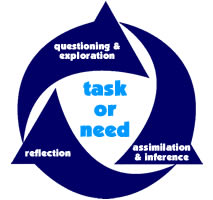 Graphic Inquiry
Graphic Inquiry
Graphic inquiry weaves visual elements throughout the inquiry process.
- Content. Explore an animal cell diagram and the interactive Inside a Cell to learn about cells.
- Context. Give the generic cell a face. Read The Immortal Life of Henrietta Lacks by Rebecca Skloot, watch Hela Cell, and explore Henrietta Lacks (HeLa) website. Locate public domain and copyleft images of HeLa cells at Wikimedia Commons. Explore a timeline. Read The Miracle of Hela from 1976 in Google Books.
- Connection. Who else has been used for medical research without their knowledge? Transfer your understandings. Explore medical ethics and issues in medical research. Ask students to create a video about their findings and post it on Vimeo.
Even before we learn about inquiry in school, each of us begins our life as an inquirer. Inquiry is a part of our lives both inside and outside the classroom. Read about students as information scientists and Annie's Inquiry and Danny's Inquiry. Read about student maturation and inquiry.
 What did you investigate as a child? What do you investigate as an adult? Think about how you matured as an information scientist. How was your passion for inquiry ignited and nurtured?
What did you investigate as a child? What do you investigate as an adult? Think about how you matured as an information scientist. How was your passion for inquiry ignited and nurtured?
Graphic Inquiry in Teaching and Learning
 Design learning environments that infuse graphic techniques and technologies throughout the inquiry process to address standards and promote deep thinking.
Design learning environments that infuse graphic techniques and technologies throughout the inquiry process to address standards and promote deep thinking.
Inquiry is "a process that involves asking questions and searching for evidence that can be used to design arguments, make decisions, and draw conclusions" (Lamb & Callison, 2010). It's an active process that addresses meaningful questions.
Many information search and inquiry models help young people discover the joys of investigation.
- Inquiry Components by Danny Callison. Callison contends that all the models contain a basic set of components (shown on right).
- The Big 6 by Mike Eisenberg and Bob Berkowitz. This is a popular and traditional view of information search.
- The Ws by Annette Lamb. This model contains elements associated with the feelings and actions young people experience as they work their way through the recursive process of inquiry.
Inquiry is an active process. Graphics are often overlooked when designing inquiry-based learning environments. Diagrams, line drawings, photos, maps, charts, and graphs can be woven throughout the process.
Learn more about Information Age Inquiry at my online course.
For a more in-depth exploration, read the graphic book Graphic Inquiry by Annette Lamb and Danny Callison available from Libraries Unlimited, 2011.

